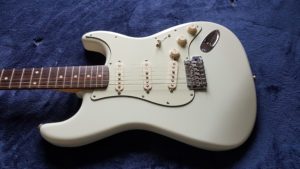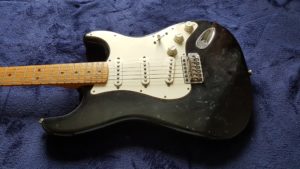New or Used?
Ah, it’s finally time to buy a new guitar (and this month is only the third time that time has come!). Sure, you could buy a brand new one, just off the factory guitar. This will not guarantee perfection by any means (we have already covered that here), but paying the full price will come with all the EU consumer’s rights such as a cool manufacturer warranty and a returning policy of any kind.

But what if you are not up to paying the full price or simply you are looking for something discontinued…or simply like the pre-loved patina better? You go to a place (or, rather, multiple virtual places) of temptations and perdition called “second hand markets” where you deal mostly with privates willing to sell their gear. In recent times, this market has become more relevant than ever! That’s great but that’s also an extra reason to be careful.

Buying a used guitar can be a very satisfying journey but automatically inverts the reassuring pros/cons ratio of buying a new instrument: you’ll expect better prices, availability of now discontinued models but of course you get no official warranties or policies.
–
Let’s try to make this adventure as pleasant and safe as possible with a couple of tips then. Oh, and of course, if you’d like to dive into this even more safely and prefer to have a professional opinion, you know what to do! We do offer professional inspections!
Viewing a Second Hand Guitar: a Shortlist
So, an agreement on the price has been met, meeting time has come and you will finally be able to cast an eye over this beauty, in search of any deal-breakers.
But what do you need to actually check out?
Let’s start by saying that not all the potential flaws have the same importance. A crackling potentiometer is nothing if compared to a worn fretboard. That’s why, for your convenience, the checklist will follow a “most important to a least important” order. Enjoy it!
Checklist
- The neck. This is the most important component of a guitar and everything in it has to be up to scratch or the playability of the instrument will be highly impacted. Also, the repair may be extremely expensive. What to check. The bare minimum would be checking that the truss rod nut is not stripped and that the truss rod has margin to turn either direction, clockwise and counter-clockwise. If there are noticeable signs of clumsy adjustments around the truss rod insert (like in the pic linked above), well, that’s a big red flag. Another very red flag would be, in the case of a Gibson style truss rod nut, that the truss rod threads are much exposed beyond the nut. To clarify, it should look more like this (little to none thread exposure), not so much like this.
- Body/neck angle. Mostly for acoustic guitars. These, because of their structure, tend to fold up under string tension over time; the result is that the neck will slowly move to a different angle in relation to the body and the action will become higher and higher, until it reaches a point where it is beyond adjustment. And that would require a very expensive procedure to be rectified. What to check. Two things mainly. (1) The bridge saddle exposure in relation to the string action. In other words, if the string action is very high and the bridge saddle is very low, almost flush with the wooden bridge, we clearly got a red flag. (2) A little more scientific maybe (yet still very straightforward): you can test the body/neck angle by simply lying a long straight edge (about 60cm) in the middle of the fretboard. Check where its edge meets the bridge top (here an explicative article with pics from frets.com).
- Wood cracks/fractures. Enough said! Check in particular if you can see any crack lines (1) behind the neck, where headstock and neck meet (pic here), (2) signs of fretboard delamination (pic), (3) cracks on the front/sides/back on acoustic guitars.
- Frets size and condition. It’s quite normal for used guitar to present some sign of frets wear to a certain extent, expecially in the first positions (pic), however how deep these gouges are will determine how low the frets will be after the next fret leveling. Also, if the frets look to be already pretty short in size to start with (pic), no leveling would make much sense and a more expensive service, a refret, would be needed.
- Bridge coming loose (for acoustic guitars). Take just a second to check if the bridge is lifting off the body (like this or this).
- Hardware condition. Does everything look in good order if compared with a stock photo of the same guitar model? Is there anything missing or different from the factory specs? If the metal parts look a little tarnished, that will not represent a major issue really; rust will though. Also, if the guitar originally comes equipped with a certain pickups set, be sure you got the same set in there (or better, sure).
- Wiring condition. If you can get the instrument plugged in an amp, test all the components. Quite frankly, it’s not a big deal if the potentiometers or the jack are a little noisy, or even dead quiet. A repair is relatively inexpensive in this case.
It seems like you have to check a lot of things but, once you get used, going through the checklist will be like an easy and automatic routine (gif), which will eventually save you from having some troubles.
Final considerations
What if the guitar presents some/a lot of fret buzz? Well, that’s not necessarily a red flag. It might be simply due to the setup (or lack thereof) or to some fret work needed. On the other hand, a guitar with a very high string action which presents buzz and bends choking might be a no-go. Does the action feel very low? Do the frets look quite worn?
What if I have to buy a used guitar from a private online? That’s always a risk, yes. That’s why using some platforms that guarantee some buyer protection (Reverb, Ebay) is a very good idea. Also, is the seller responsive and willing to provide extra pictures on request or he seems like he can’t wait to unload a burden? Think, think, think, decide.
What to pay attention to when you are actually playing the instrument? Mainly the things that can’t be changed (well, in theory). Do you like the neck profile, the pickups configuration, the way the instrument sits on your lap? Does it feel right (even though still improvable) under the fingers?
